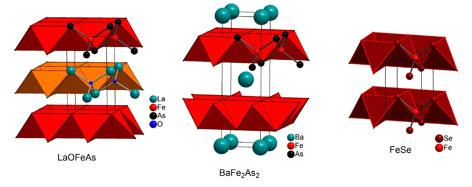Concept

The modern age of superconductivity started in 1986 with the discovery by Bednorz and Müller of high-temperature superconductors (HTSC), in which an exotic coupling mechanism yields a critical temperature, Tc, above liquid nitrogen temperature (77 K). Till now many of the promises of these materials have not been kept. In fact, on the one hand we are still far from a full understanding of the coupling mechanisms and, on the other hand, due to the structural complexity, anisotropy, and bad metallicity of these compounds, only a few niche applications have been realized.
The new century has started with the discovery of MgB2 (Akimitsu, January 2001). In this case, it was soon understood that conventional electron-phonon coupling in a complex multiband framework determines superconductivity at Tc=40 K. This simple, metallic, cheap, and light compound has just proved to be suitable for cryogen-free applications.
Finally, in February 2008, the discovery of a Fe-based superconductor (FeSC), LaFeAs(O1-xFx) with Tc of 26 K, was announced by Hosono et al.. This event prompted an army of physicists and chemists to discover other different families (referred to as “1111” for REFeAsO, “122” for AFe2As2, “111” for AFeAs, “11” for Fe(Te,Se)) with critical temperatures ranging from 55 K to 19 K in the optimally doped compounds, and incredibly high upper critical fields.
Two years after Hosono’s discovery two crucial questions arise. The first is: will FeSC be instrumental in deciphering the 22-year-old mystery behind high-Tc superconductivity? The second is: will FeSCs be simpler and tamer materials for applications than the HTSCs?
The present consortium believes that it is more urgent to explore their potential for applications with significant socio-economic benefits, such as the likely gain in energy efficiency.
Thus, in SUPER-IRON, we will address the latter question.
FeSCs share several characteristics with HTSCs, such as the layered structure, the coexistence of different orderings, the occurrence of superconductivity upon doping, the small coherence length, and the nonconventional pairing. Some of these aspects have shown to be unsuitable for practical application. However, FeSCs exhibit several advantages with respect to HTSCs; namely, they are metallic in the parent compounds, the anisotropy is generally smaller and not strongly dependent on the level of doping, the supposed order parameter symmetry seems to be different, and, in principle, not so detrimental to current transmission across grain boundaries (GBs), and impurities do not affect Tc significantly.
FeSCs share characteristics also with the more conventional MgB2. The most remarkable one is the multiband nature that has offered unprecedented tools in MgB2 to tune and improve the superconducting properties, and needs to be carefully investigated also in FeSC.
Moreover, FeSCs appear to be extremely versatile in terms of chemical composition, as they belong to a comprehensive class of materials, where many chemical substitutions are possible, and their layered structure allows designing new FeSC with composite structures or even artificial multilayers. This versatility could allow to tailor the superconducting properties for the commercial technologies.
Different synthesis methods (i.e. solid state reaction, high pressure synthesis, and flux method) have been developed for growing single crystals or polycrystalline materials. Thin films of good quality are obtained by laser ablation. But due to the tricky chemistry of these compounds, the toxicity and volatility of arsenic and the presence of iron which could give rise to magnetic secondary phases, many efforts are yet to be done for improving the quality (homogeneity, purity, crystallinity, ..) of samples. This is even more crucial in poly-crystalline materials; indeed, up to now these compounds have shown strong electromagnetically granular behaviour.




 Based on the Exchange of Letters, JST and EC DG RTD have agreed to establish a new scheme for coordinated funding of Japanese-EU coordinated research projects (see European Community press release IP/09/1844). After consultations between JST and EC DG RTD, “Superconductivity” has been selected as the field of research for the coordinated funding scheme.
Based on the Exchange of Letters, JST and EC DG RTD have agreed to establish a new scheme for coordinated funding of Japanese-EU coordinated research projects (see European Community press release IP/09/1844). After consultations between JST and EC DG RTD, “Superconductivity” has been selected as the field of research for the coordinated funding scheme.